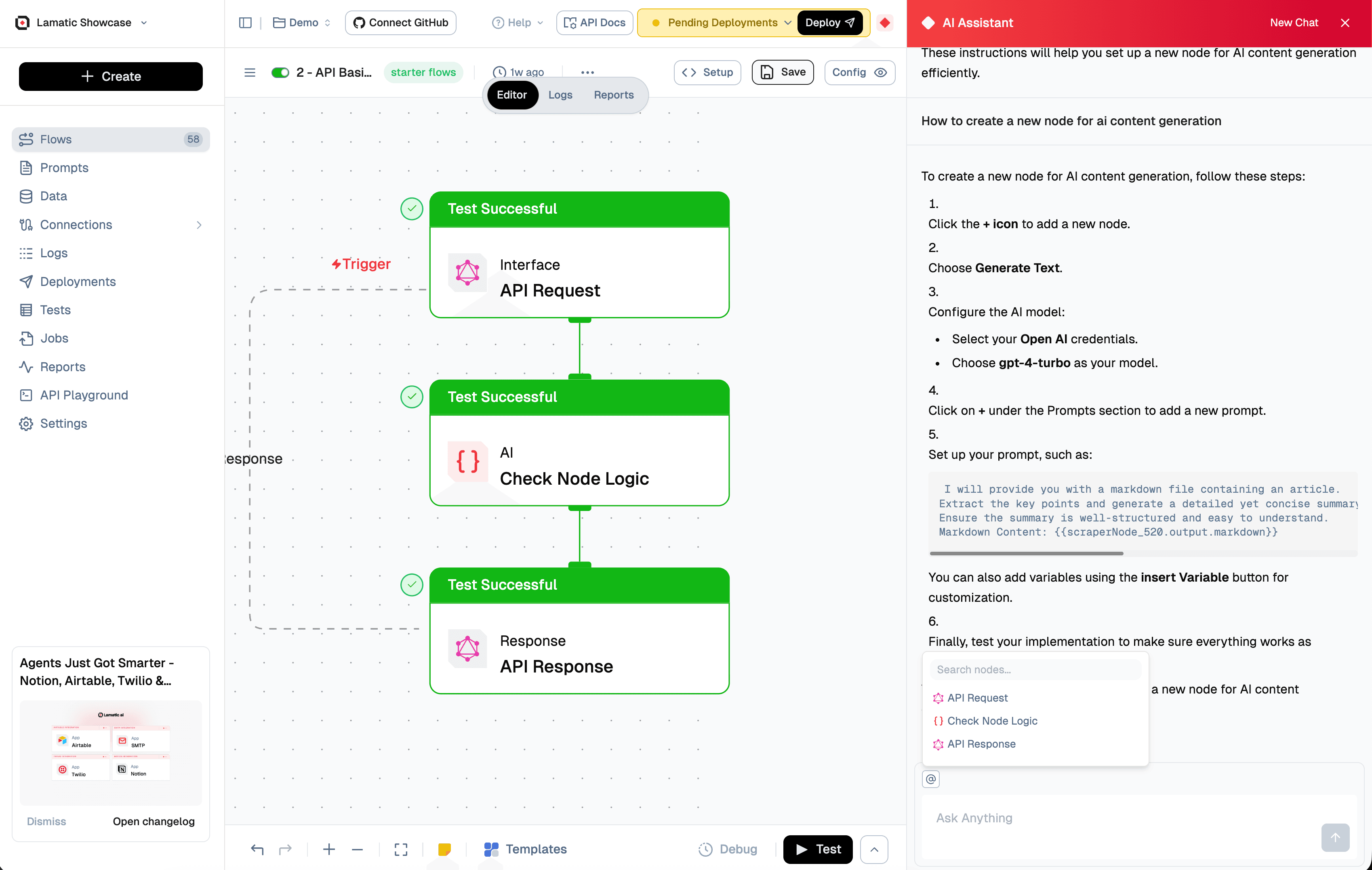Flow AI Assistant

Note: The Flow AI Assistant may occasionally provide improper or inaccurate responses. Please manually verify all instructions and configurations provided by the assistant. Our team is continuously working to improve this feature for better accuracy and reliability.
The Flow AI Assistant is an intelligent helper integrated directly into the Flow Editor that guides you through building and configuring flows with step-by-step instructions. It simplifies complex workflows and makes the flow editor more accessible, whether you're creating simple automation or sophisticated multi-node flows.
What is the Flow AI Assistant?
The Flow AI Assistant is a contextual AI-powered panel that appears on the right side of the Flow Editor. It provides real-time guidance, step-by-step instructions, and answers to questions about building flows in Lamatic. The assistant understands your workflow context and offers relevant help based on what you're trying to accomplish.
Key Features
Step-by-Step Guidance
The AI Assistant provides detailed, numbered instructions for common tasks, such as:
- Creating new nodes for specific purposes
- Configuring AI models and credentials
- Setting up prompts and templates
- Connecting nodes in the correct sequence
- Testing and debugging flows
Contextual Help
The assistant understands your current flow context and provides relevant suggestions:
- Node Creation: Get instructions on how to add and configure specific node types
- Configuration Help: Learn how to set up credentials, models, and parameters
- Flow Logic: Understand how to structure complex flows with multiple nodes
- Best Practices: Receive tips on optimizing your workflows
Interactive Chat Interface
Use the "@" to Select Specific Node:
- Ask questions about specific nodes or configurations
- Get help with error messages
- Request examples for your use case
- Learn about advanced features and techniques
How to Use the Flow AI Assistant
Accessing the Assistant
Method:
- Open any flow in the Flow Editor
- Click on the "AI Assistant" tab on the right side of the screen
- The assistant panel will open, ready to help
Getting Help with Node Creation
The AI Assistant can guide you through creating and configuring nodes:
Example: Creating an AI Content Generation Node
- Ask the assistant: "How do I create a node for AI content generation?"
- The assistant will provide step-by-step instructions:
- Click the ➕ icon to add a new node
- Choose "Generate Text" from the node selection menu
- Configure the AI model (select credentials and choose a model like
gpt-4-turbo) - Add a prompt in the Prompts section
- Test your implementation to ensure it works correctly
Building Complex Flows
The AI Assistant excels at helping you create sophisticated workflows:
Method:
- Describe your goal or use case to the assistant
- The assistant will break down the task into manageable steps
- Follow the provided instructions to build your flow node by node
- Ask follow-up questions if you need clarification on any step
Example Use Cases:
- Multi-step data processing pipelines
- Conditional logic and branching flows
- Integration with external APIs and services
- Complex AI workflows with multiple models
- Error handling and retry mechanisms
Getting Configuration Help
When configuring nodes, the assistant can help with:
- Credentials Setup: Learn how to connect external services
- Model Selection: Understand which AI models work best for your use case
- Prompt Engineering: Get tips on writing effective prompts
- Variable Mapping: Learn how to reference outputs from previous nodes
Method:
- Select a node in your flow
- Ask the assistant about specific configuration options
- Follow the detailed instructions provided
Benefits of Using the AI Assistant
Easier Flow Creation
- Reduced Learning Curve: New users can quickly understand how to build flows
- Guided Workflows: Step-by-step instructions eliminate guesswork
- Contextual Help: Get relevant information based on what you're working on
Building Complex Flows
- Break Down Complexity: The assistant helps decompose complex requirements into manageable steps
- Best Practices: Learn optimal patterns for structuring flows
- Error Prevention: Get guidance that helps avoid common mistakes
- Advanced Techniques: Discover features and methods you might not know about
Time Savings
- Quick Answers: Get immediate help without searching documentation
- Focused Guidance: Receive specific instructions for your exact use case
- Troubleshooting: Quickly resolve issues with targeted help
Best Practices
- Be Specific: When asking questions, provide context about what you're trying to achieve
- Follow Instructions: The assistant provides detailed steps—follow them in order
- Ask Follow-ups: If something isn't clear, ask for clarification
- Test as You Go: After following instructions, test your flow to ensure it works correctly
- Learn Patterns: Pay attention to the patterns the assistant teaches—they apply to many use cases
The Flow AI Assistant transforms the Flow Editor into a more intuitive and powerful tool, making it easier to build both simple automations and complex, multi-node workflows. Whether you're a beginner or an advanced user, the assistant provides valuable guidance to help you create flows more efficiently and effectively.